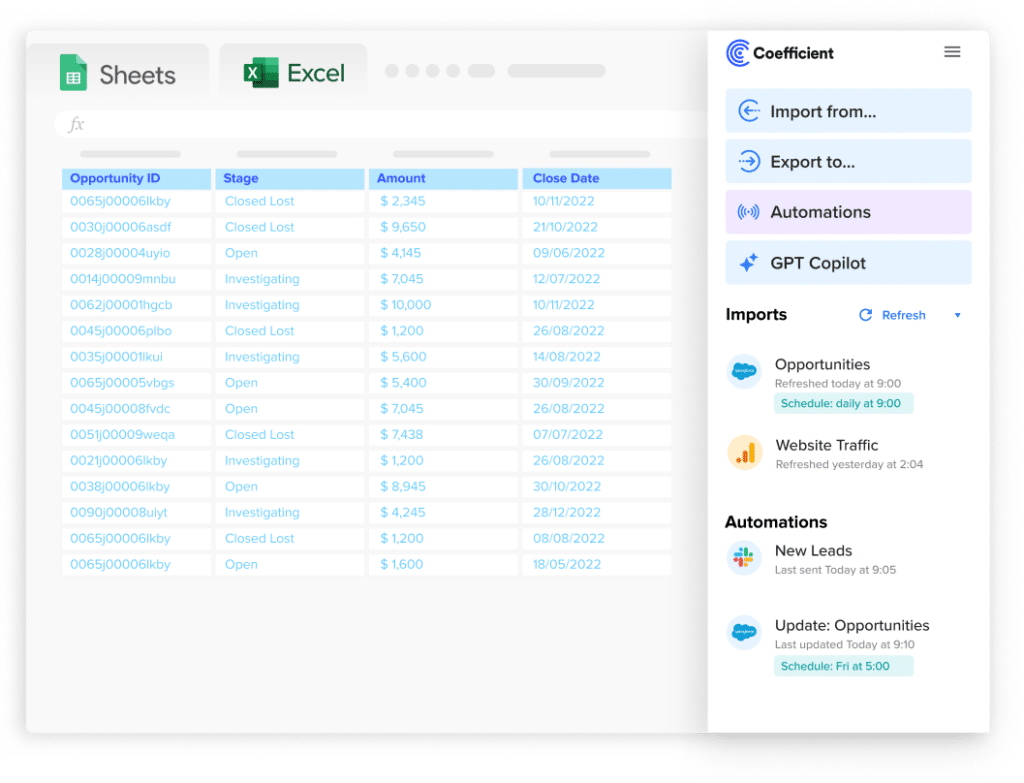Business intelligence & data visualization shouldn’t cost a fortune or require a PhD to understand. Yet here you are, staring at Tableau’s $75-115 monthly per-user pricing, wondering if there’s a simpler way to turn your data into insights. You’re not alone.
Tableau revolutionized data visualization with its drag-and-drop interface and powerful charting capabilities. But its enterprise focus and premium pricing often overshadow simpler business needs. Many teams just want to understand their data without learning complex BI platforms or managing hefty software budgets.
The good news? Modern alternatives deliver compelling BI capabilities at various price points and complexity levels, from spreadsheet-native solutions to open-source platforms.
What is Tableau?
Tableau stands as the premium leader in business intelligence and data visualization. The platform transforms raw data into interactive dashboards, charts, and reports through an intuitive drag-and-drop interface that doesn’t require coding skills.
Core capabilities center on powerful data visualization and analysis tools. Tableau connects to hundreds of data sources, from Excel spreadsheets to enterprise databases like Salesforce, Oracle, and Snowflake. Advanced features include:
- Calculated fields and parameters
- Sophisticated statistical functions
- Complex analytical scenarios
- Enterprise-scale data handling
Data preparation tools help clean and structure data before analysis:
- Tableau Prep enables data blending and pivoting
- Transformation workflows handle complex data scenarios
- Large dataset processing with performance optimization
- Enterprise-scale deployment capabilities
Enterprise features include:
- Comprehensive security controls and user management
- Governance capabilities and audit trails
- Tableau Server for centralized deployment
- Advanced collaboration tools with commenting and subscriptions
- Mobile access for executive dashboards
Target audience focuses on data analysts, business intelligence professionals, and enterprise teams requiring sophisticated visualization capabilities:
- Finance departments use Tableau for complex financial reporting
- Marketing teams analyze campaign performance across multiple channels
- Operations teams monitor KPIs and performance metrics in real-time dashboards
Pricing reflects enterprise positioning with three main tiers:
- Tableau Creator at $115 per user monthly (full development capabilities)
- Tableau Explorer at $42 per user (viewing and limited editing)
- Tableau Viewer at $27 per user (read-only access to published dashboards)
Market leadership comes through extensive feature depth, strong community support, and comprehensive training resources. Gartner consistently ranks Tableau as a Leader in Analytics and Business Intelligence Platforms. The platform excels at complex data analysis scenarios that simpler tools cannot handle effectively.
However, high costs and complexity create barriers for many teams:
- Learning curves require significant time investment
- Small businesses often find pricing prohibitive for basic reporting needs
- Complex feature sets overwhelm users with simple requirements
Why look for Tableau alternatives?
Cost considerations drive most alternative searches. Tableau’s minimum investment of $27 per user monthly quickly escalates for growing teams. A 20-person organization faces $6,480 annually just for basic viewing access, before considering Creator licenses for dashboard development.
Complexity challenges overwhelm teams needing straightforward reporting:
- Tableau’s extensive feature set creates learning barriers for business users
- Teams simply wanting to visualize sales data or track project metrics face steep learning curves
- Many organizations struggle with user adoption despite significant training investments
Use case misalignment occurs when simple needs meet enterprise solutions:
- Teams wanting to enhance existing spreadsheet workflows don’t need Tableau’s full BI platform
- Others require specific features like real-time monitoring or embedded analytics
- Specialized alternatives often handle focused requirements better than general-purpose platforms
Technical requirements vary significantly across organizations:
- Some teams prefer cloud-native solutions over server deployments
- Others need open-source flexibility for customization
- Specific integration capabilities that Tableau doesn’t prioritize in their roadmap development
Top 8 Tableau alternatives
1. Power BI

Microsoft Power BI leverages deep integration with the Microsoft ecosystem to deliver enterprise BI capabilities at competitive pricing. The platform serves over 5 million users globally through familiar Microsoft interfaces and workflow integration.
Microsoft ecosystem advantages include:
- Seamless connectivity with Excel, SharePoint, Teams, and Office 365
- Data flows naturally between applications without complex integration setup
- Azure cloud services provide scalable infrastructure
- Advanced security controls that enterprise IT departments prefer
Best for organizations heavily invested in Microsoft technologies:
- Finance teams benefit from Excel integration and familiar ribbon interfaces
- Sales teams connect Power BI dashboards directly to Outlook and SharePoint
- Streamlined reporting workflows within existing Microsoft infrastructure
AI capabilities through Power BI’s features:
- Natural language queries enable business users to ask questions in plain English
- Quick insights automatically identify trends and anomalies in datasets
- Smart narrative features generate written summaries of chart insights for executive reporting
Pricing competitiveness provides significant value compared to Tableau:
- Power BI Pro at $14 per user monthly (most features for small businesses)
- Premium Per User at $24 monthly (advanced analytics and larger dataset support)
- Substantial cost savings compared to Tableau’s pricing structure
Enterprise features include:
- Row-level security and advanced governance tools
- Comprehensive audit capabilities
- Power BI Report Server for on-premises deployment
- Integration with Azure Active Directory for simplified user management
Mobile optimization delivers:
- Full-featured apps for iOS and Android
- Offline access capabilities
- Executive dashboards remain accessible during travel
- Automatic sync when connectivity returns
Limitations include:
- Less sophisticated visualization options compared to Tableau
- Occasional performance issues with very complex reports
- Limited capabilities with extremely large datasets
2. Looker Studio

Google Looker Studio (formerly Data Studio) offers comprehensive BI capabilities for free, making it the most accessible alternative to expensive enterprise platforms. Google’s commitment to free access democratizes business intelligence for small businesses and individual users.
Google ecosystem integration provides:
- Seamless connectivity to Google Analytics, Google Ads, Google Sheets, and BigQuery
- Pre-built connectors eliminate setup complexity for popular Google services
- Data flows automatically without authentication challenges
- No API configuration requirements
Best for marketing teams and Google Workspace organizations requiring straightforward reporting:
- Digital marketers create campaign performance dashboards combining Google Ads, Analytics, and Search Console data
- Content teams track website performance and social media metrics in unified views
- Small businesses access professional BI features without cost barriers
Visualization capabilities include:
- Standard charts, tables, and geographic maps
- Customization options for branding and styling
- Interactive filters enable drill-down analysis
- Dynamic data exploration capabilities
- Calculated fields support basic data transformations and custom metrics
Collaboration features mirror Google’s sharing model:
- Real-time editing and comment threads
- Granular permission controls
- Teams coordinate around shared dashboards
- Familiar Google Workspace interfaces and notification systems
Third-party connectors extend data source options:
- Google’s partner ecosystem and community-built connectors
- Popular business tools like Salesforce, HubSpot, and Facebook
- Marketplace add-ons for additional integration capabilities
Pricing model includes:
- Generous free tier for most users
- Looker Studio Pro at $9 per user monthly for advanced features
- Team collaboration and enhanced support
- Enterprise features require BigQuery integration for additional costs
Performance limitations emerge with:
- Complex datasets or intensive calculations
- Advanced statistical functions remain limited
- Sophisticated data modeling capabilities compared to enterprise alternatives
3. Coefficient

Coefficient revolutionizes business intelligence by bringing enterprise data directly into your existing spreadsheets. Rather than forcing teams to learn new BI platforms, Coefficient transforms Excel and Google Sheets into powerful analytical tools with live data connections and AI-powered insights.
Live data integration connects over 100 business systems directly to spreadsheet cells:
- Salesforce opportunities, HubSpot contacts, NetSuite financials refresh automatically
- Database queries update on schedules you control
- No more manual data exports or stale dashboard screenshots
- Real-time business data without platform switching
Best for spreadsheet-native teams who love their current analytical workflows but need access to real-time business data:
- Finance teams build dynamic P&L statements with live accounting data
- Sales teams create territory performance dashboards that update automatically
- Marketing teams track campaign ROI with real-time advertising spend and conversion data
AI Sheets assistant transforms spreadsheet analysis through natural language interaction:
- Ask questions like “Which sales reps are behind quota this quarter?” and receive instant insights
- Builds pivot tables, suggests formulas, and identifies data patterns
- Charts and trend analysis without requiring BI expertise
- No technical skills needed for advanced analytics
Enterprise data access includes:
- Direct connections to data warehouses, APIs, and cloud databases
- Teams access the same data sources that power enterprise BI platforms
- Familiar spreadsheet interfaces maintain user-friendly experiences
- Row-level security and governance controls satisfy IT requirements
BI-quality visualizations generate:
- Professional charts and dashboards that auto-update with live data
- Executive presentations with dynamic charts that refresh before every board meeting
- Spreadsheets become authoritative business intelligence tools
- Publication-ready reports without additional formatting
Pricing starts at $49 monthly for teams:
- Advanced plans at $99 for unlimited data sources and enterprise features
- No per-user restrictions make Coefficient cost-effective for growing teams
- Significant savings compared to traditional BI platform licensing
- Team-based pricing scales better than per-user alternatives
Competitive advantage lies in:
- Eliminating the BI learning curve while providing enterprise-grade data access
- Teams keep familiar workflows while gaining powerful analytical capabilities
- Enterprise-quality results without platform migration requirements
4. Qlik Sense

Qlik Sense differentiates itself through associative analytics that enables unlimited data exploration without predefined query paths. The platform’s unique in-memory processing reveals hidden data relationships that traditional BI tools miss.
Associative model allows users to:
- Click on any data point and instantly see related information across all connected datasets
- Eliminate rigid drill-down hierarchies that limit exploration in other BI platforms
- Discover insights organically through natural data interactions
- Explore data relationships without predetermined paths
Best for data discovery and exploratory analysis scenarios:
- Business analysts uncover unexpected trends and correlations through flexible data exploration
- Finance teams investigate budget variances by exploring related cost centers and time periods
- Sales teams analyze customer patterns across multiple dimensions simultaneously
Self-service capabilities enable:
- Business users to build their own analyses without IT dependency
- Drag-and-drop interfaces combined with smart search functionality
- Users find relevant data quickly
- Automated suggestions guide analysis directions based on data relationships
Enterprise deployment options include:
- Cloud, hybrid, and on-premises installations
- Comprehensive security and governance controls
- Multi-tenancy support for large organizations
- Multiple business units served from single deployments
Pricing follows capacity-based models:
- Starting around $200 monthly for small deployments
- Scaling to $2,750+ for enterprise installations
- Professional licensing at $1,950 per user annually for power users
- Full development capabilities included
Mobile applications provide:
- Native iOS and Android experiences
- Full analytical capabilities on mobile devices
- Offline access ensures dashboard availability during travel
- Automatic synchronization when connectivity returns
Learning curve requires:
- Time investment to master associative concepts
- Navigation paradigms that differ significantly from traditional BI tools
- Understanding of unique data exploration approaches
5. Sisense

Sisense focuses on AI-driven analytics for complex data scenarios that traditional BI tools struggle to handle effectively. The platform simplifies big data analysis through automated machine learning and intelligent data preparation capabilities.
AI capabilities automatically:
- Detect patterns, anomalies, and trends in large datasets without manual configuration
- Generate natural language insights that explain chart findings in business-friendly language
- Provide predictive analytics that suggest future trends based on historical data patterns
- Recommend data analysis directions based on dataset characteristics
Best for organizations with complex data integration needs and advanced analytical requirements:
- Retail companies analyze customer behavior across multiple channels and touchpoints
- Manufacturing organizations monitor production efficiency and quality metrics
- Real-time dashboards for complex operational scenarios
Data preparation automation:
- Handles complex ETL processes through AI-powered recommendations
- Suggests joins, transformations, and cleaning operations based on data characteristics
- Business users can work with prepared datasets without understanding underlying data complexity
- Automated data quality and consistency checks
Industry solutions provide:
- Pre-built analytics for healthcare, retail, financial services, and manufacturing sectors
- Domain-specific KPIs and compliance requirements
- Workflow integration accelerates implementation for specialized business requirements
- Regulatory compliance features for specific industries
Pricing reflects enterprise positioning:
- Implementations typically starting around $40,000 annually
- Scaling to $300,000+ for large deployments
- Custom pricing considers data volume, user count, and feature requirements
- Enterprise-grade support and professional services included
White-label capabilities enable:
- Software vendors to embed Sisense analytics into their own applications
- OEM partnerships allow product teams to add BI features
- No need to build analytical infrastructure from scratch
- Revenue sharing and licensing models available
Implementation complexity requires:

Stop exporting data manually. Sync data from your business systems into Google Sheets or Excel with Coefficient and set it on a refresh schedule.
Get Started
- Significant technical resources and time investment
- Dedicated BI teams rather than business user self-service scenarios
- Professional services and training programs
6. Domo

Domo positions itself as the cloud-native BI platform designed for executive dashboards and mobile-first analytics. The platform emphasizes real-time data access and executive-friendly interfaces for C-level decision making.
Executive focus drives design decisions toward:
- Clean, mobile-optimized dashboards that work equally well on phones and large displays
- Pre-built executive templates cover common KPI scenarios
- Sales performance, financial metrics, and operational efficiency dashboards
- C-level friendly interfaces and navigation
Best for leadership teams requiring high-level business monitoring without analytical complexity:
- CEOs track company performance through comprehensive executive dashboards
- Board members access key metrics during meetings through tablet-optimized interfaces
- Executive reporting without technical complexity
Real-time capabilities enable:
- Immediate data refresh from connected systems
- Sales dashboards update as deals close
- Marketing metrics reflect current campaign performance
- Financial reporting shows today’s revenue and expense data
Collaboration features include:
- Annotation and discussion threads around specific data points
- Alert systems that notify stakeholders when metrics exceed defined thresholds
- Teams coordinate around shared dashboards
- Notification workflows and escalation procedures
Data integration connects:
- Over 1,000 business applications through pre-built connectors and APIs
- Popular systems like Salesforce, Google Analytics, and QuickBooks
- Integration without custom development work
- Automated data refresh and synchronization
Pricing starts around $20,000 annually for small teams:
- Enterprise deployments reaching $100,000+ based on user count and feature requirements
- Custom pricing reflects the platform’s executive positioning
- Professional services and training included
Mobile applications provide:
- Native experiences across iOS and Android devices
- Offline access capabilities for critical dashboards
- Push notifications alert executives to important metric changes
- Location-independent access to business metrics
7. Metabase
Metabase champions open-source transparency in business intelligence with free self-hosted deployment and optional cloud services. The platform prioritizes simplicity and accessibility over advanced enterprise features.
Open-source benefits include:
- Complete source code access and transparency
- Community-driven development and feature requests
- Freedom from vendor lock-in and licensing restrictions
- Organizations can customize functionality and integrate with proprietary systems
- Full control over BI infrastructure and data
Best for technical teams and cost-conscious organizations requiring basic BI capabilities:
- Startups access professional BI features without software licensing costs
- Development teams create internal dashboards for application monitoring
- User analytics and operational metrics tracking
SQL-based approach enables:
- Technical users to write custom queries for complex analysis
- Visual query builders for business users without SQL knowledge
- Dual approach serves both technical and non-technical users within single organizations
- Flexible data access without rigid interface constraints
Self-hosting options provide:
- Complete data control and privacy protection
- Organizations handle sensitive data within their own infrastructure
- Full analytical capabilities while maintaining security
- Cloud hosting offers convenience for teams preferring managed services
Pricing includes:
- Free self-hosted deployment with unlimited users
- Metabase Cloud starting at $85 monthly for hosted convenience
- Enterprise features like advanced permissions and audit logs require custom pricing
- No per-user licensing restrictions
Community support provides:
- Extensive documentation, tutorials, and user forums
- Active open-source community contributes connectors and visualizations
- Feature improvements without additional licensing costs
- Regular release cycles deliver new capabilities
Feature limitations compared to enterprise platforms include:
- Fewer advanced visualization options and chart types
- Limited statistical functions and analytical capabilities
- Basic collaboration capabilities compared to enterprise alternatives
- Serves straightforward BI needs rather than complex analytical scenarios
8. Grafana

Grafana excels at real-time monitoring and observability with strong capabilities for time-series data visualization. While primarily designed for IT monitoring, the platform serves BI use cases requiring live data dashboards and alerting.
Real-time strength shows through:
- Exceptional performance with streaming data and frequent updates
- Dashboards refresh automatically with sub-second latency
- Operational monitoring scenarios without performance degradation
- Time-series visualizations excel at showing trends and patterns over time periods
Best for operations teams requiring real-time business monitoring alongside IT infrastructure:
- E-commerce companies track website performance, sales metrics, and customer activity in unified dashboards
- Manufacturing organizations monitor production metrics, quality indicators, and equipment performance
- Real-time operational intelligence and business monitoring
Data source flexibility includes:
- Direct connections to databases, APIs, and monitoring systems
- Pre-built connectors support popular time-series databases like InfluxDB, Prometheus, and ElasticSearch
- SQL queries enable connectivity to traditional business databases
- Custom data source plugins for specialized requirements
Alerting capabilities notify stakeholders when metrics exceed defined thresholds:
- Email, Slack, PagerDuty, and webhook integrations
- Complex alert rules support multiple conditions and escalation procedures
- Critical business metrics monitoring and notification
- Automated response workflows for operational issues
Pricing includes:
- Free self-hosted deployment with unlimited users
- Grafana Cloud offering usage-based pricing starting around $8 monthly
- Enterprise features like advanced authentication and support require custom pricing
- Cost-effective for teams with technical deployment capabilities
Open-source foundation provides:
- Complete customization freedom and active community development
- Plugin ecosystem extends functionality with community-contributed visualizations
- Data sources and dashboard templates available
- No vendor lock-in or licensing restrictions
Learning curve requires:
- Understanding of time-series concepts and query languages
- Technical deployment and configuration knowledge
- Platform serves specific use cases well but may be overpowered for basic business reporting needs
How to choose the right alternative
Start with your team’s current workflow:
- Teams comfortable with Microsoft Office find Power BI integration valuable and familiar
- Google Workspace organizations benefit from Looker Studio’s seamless connectivity
- Spreadsheet-native teams should evaluate Coefficient’s enhancement approach that preserves existing workflows while adding enterprise data access
Consider your budget constraints:
- Free options like Looker Studio and Metabase provide significant value for basic needs
- Mid-range platforms like Power BI and Coefficient offer enterprise features at accessible pricing
- Premium alternatives like Qlik Sense and Sisense require substantial budget justification
Evaluate technical requirements:
- Self-service scenarios favor user-friendly platforms like Power BI and Looker Studio
- Complex data integration needs benefit from specialized platforms like Sisense or Domo
- Teams wanting live business data without platform migration should prioritize Coefficient’s spreadsheet integration
Assess your analytical complexity:
- Simple reporting and dashboards work well with most alternatives
- Advanced statistical analysis and data modeling require platforms like Qlik Sense or Sisense
- Teams needing BI insights within familiar spreadsheet interfaces find Coefficient most compatible
Plan for growth and scalability:
- Consider user licensing models and feature restrictions as teams expand
- Evaluate data volume limitations and performance characteristics
- Coefficient’s team-based pricing scales better than per-user alternatives for growing organizations
Test integration capabilities with your specific data sources and business systems:
- Verify connector quality and update frequencies
- Assess data transformation and preparation requirements
- Evaluate ease of setup and ongoing maintenance needs
Transform your data analysis today
Modern business intelligence shouldn’t require choosing between powerful features and user accessibility. The best alternative depends on your team’s workflow preferences, budget constraints, and analytical complexity requirements.
Power BI delivers Microsoft ecosystem integration at competitive pricing. Looker Studio provides comprehensive features for free. Specialized platforms like Qlik Sense and Sisense handle complex analytical scenarios that simpler tools cannot address effectively.
Coefficient takes a different approach by transforming your existing spreadsheets into powerful BI tools with live data connections and AI-powered insights. Rather than forcing teams to learn new platforms, Coefficient enhances familiar workflows with enterprise-grade data access and automation capabilities.
The right BI solution eliminates manual data work while preserving the analytical flexibility that makes spreadsheets essential to business operations. Whether you need simple dashboards or sophisticated analysis, alternatives exist that balance capability with accessibility.
Start your free trial and discover how the right BI approach can transform your data analysis without abandoning the tools your team already knows and loves.

